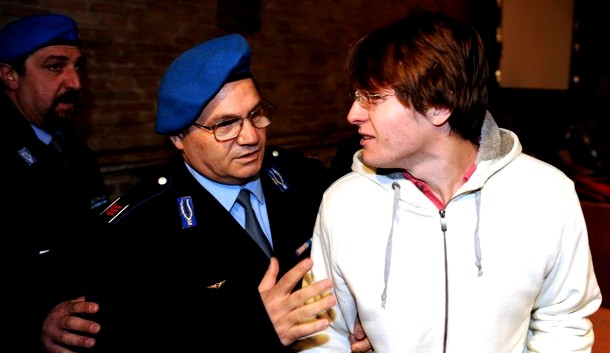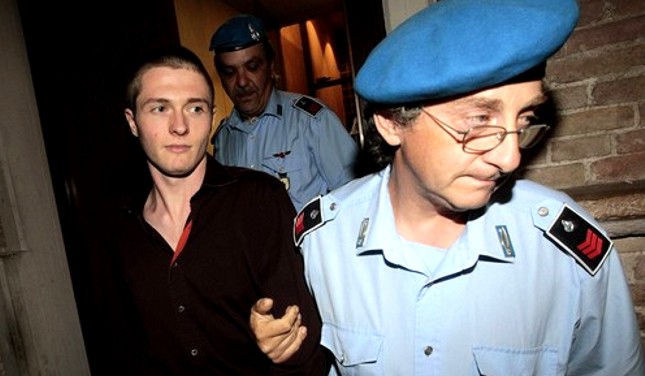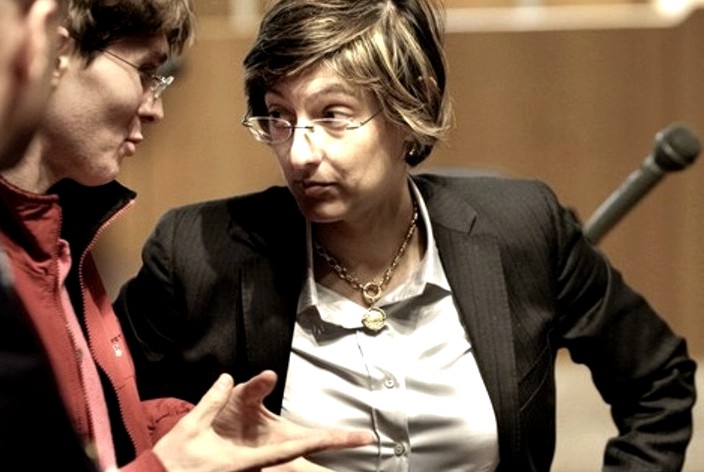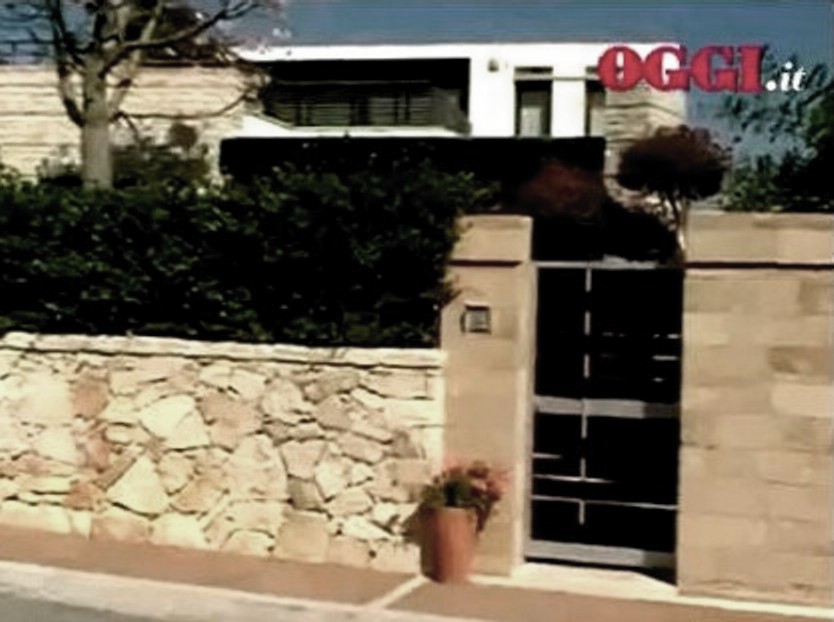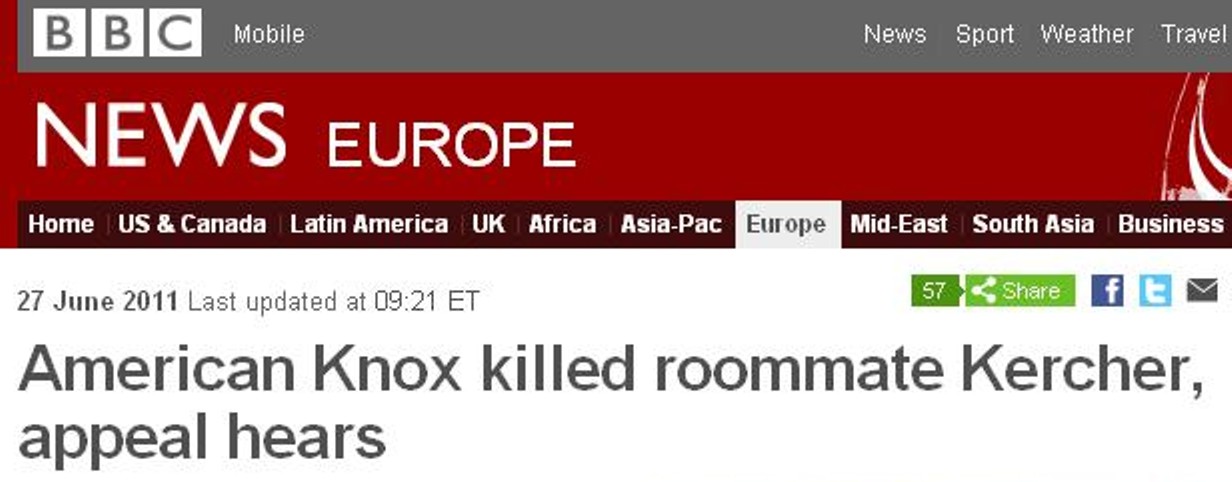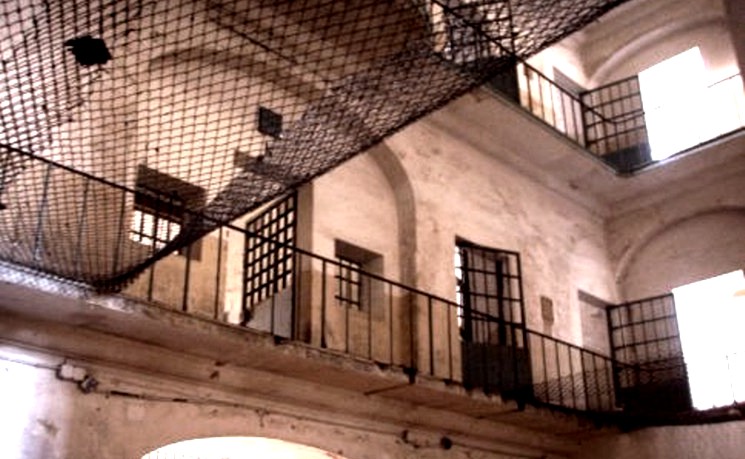
Category: Hoaxes Sollecito etc
Tuesday, September 11, 2012
Raffaele Sollecito’s DNA In Meredith’s Room Could Be Definitive Proof Of Guilt For New Appeal Jury
Posted by James Raper
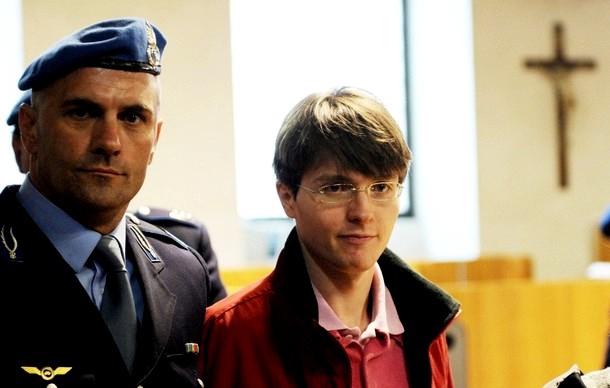
Have you followed our series on the hapless independent DNA consultants Conti and Vecchiotti? And our series on the hapless appeal judges Hellmann and Zanetti?
And our series on their formidable nemesis, Umbria’s Chief Prosecutor, Dr Galati? Who may very well convince the Supreme Court to throw out all of their work?
This post explains why their work probably deserves to be thrown out as it applies to Sollecito’s DNA in Meredith’s room, which still lacks an alternative non-damning explanation for it being there, and which could see him back serving his term in Capanne or Terni Prison before too long.
I want to start this analysis with the following verbatim quote taken from John Follain’s Death In Perugia.
“Comodi asked Vecchiotti about the alleged contamination of the bra clasp: “Is it possible for [Raffaele’s] DNA to end up only on the bra clasp?”
“Possible”, Vecchiotti said.
Comodi insisted: “Probable?”
“Probable”, Vecchiotti retorted.
Anyone who has read the Conti-Vecchiotti Report will be amazed by Vecchiotti’s above reply under cross-examination by Prosecutor Comodi. This for the simple reason that the said report did not at all evaluate the “probability” of any contamination of the bra clasp. It merely did not rule out contamination.
The Conti-Vecchiotti report with regard to the bra clasp: “It cannot be ruled out that the results obtained derive from environmental contamination and/or contamination in some phase of the collection and/or handling of the exhibit.”
On any level of understanding, if one can not rule something out then that makes it possible. But it certainly does not make it probable.
Worse was to come, with the conclusion of Hellmann-Zanetti, that contamination was probable. This though was not so surprising in as much as Hellmann-Zanetti had already indicated in their reasoning underlying the need for an independent report that they would accept the independent experts’ conclusions.
Which they did, apparently accepting Vecchiotti’s above statement on oath as definitive and which, as we can see, they appear to subsequently improve on, since the circumstances referred to below were not mentioned in the Conti-Vecchiotti Report. From Hellmann-Zanetti:
In the opinion of this Court contamination did not occur during the successive phases of treatment of the exhibit in the laboratory of the Scientific Police, but even before it’s collection by the Scientific Police.
Note that (1) the suggestion is that contamination occurred when there was no video recording (thus permitting free speculation), (2) the word “probably” is omitted here seemingly making it a definite occurrence, and (3) “even before” does not exclude contamination when the Scientific Police were there, but the circumstances described below make it, in the opinion of Hellmann-Zanetti, even more probable, it seems. Again from Hellmann-Zanetti:
..it is certain that between the first search by the scientific police, directly after the discovery of the crime, and the second search by the police, on the 18th December, the house at villa della Pergola was the object of several other searches directed towards seeking other possible elements useful for the investigation, during which the house was turned topsy-turvy, as is clearly documented by the photographs projected by the defence of the accused, but actually made by the Scientific Police. And, understandably these searches were made without the precautions that accompany the investigations of the Scientific Police, in the conviction that at that point the exhibits that needed to undergo scientific analysis had already been collected. In this context it is probable that the DNA hypothetically belonging to Raffaele Sollecito may have been transported by others into the room and precisely onto the bra clasp”¦”¦”¦..the fact that [this] is not an unusual occurrence is proven by studies cited by the expert team and also by the defence consultants”¦”¦..
So Hellmann-Zanetti are talking about the ordinary police investigators being primarily responsible.
As the Vecchiotti quote at the beginning of this post is not put in any context, it is impossible for me to know whether she was referring to the Scientific Police as seen in their videos or whether she was alluding to other recorded searches, say, by the ordinary police, but which were not on video.
What we know of the police searches is as follows. From the Massei trial sentencing report:
While forensic activity was still in progress (Note: it having been going on since the 2nd) “the house was accessed on November 4th 2007 involving, accompanied by staff from the Perugia Police Headquarters, the three occupants and housemates of the victim.
The days of November 6 and 7 were taken up by the search activity of personnel from the police headquarters of Perugia”¦.on November 6” (Note: the day after conclusion of the Scientific Police activity) “no-one entered Meredith’s room other than the three performing the search. On November 7 there was another entry into the house “for the problem of the washing machine, to collect the clothes; but I (Napoleoni) know that they did not go into the other rooms…..
They wore gloves and shoe covers….
Massei also records that Profazio stated that whilst he was aware from Stefanoni that the bra clasp had not been collected, nevertheless he had not seen it on the 6th and 7th.
As we know, the Scientific Police returned to the house on the 18th December specifically for the purpose of collecting the bra clasp (the first thing they did) and using luminol, and in addition to this being on video the defence lawyers were watching the live recording outside. It was observed by the defence lawyers at that stage that the mattress was in the living room and that articles had been moved around (topsy-turvy) in her bedroom.
From the above it might be reasonable to conclude that it was not only the Scientific Police who took the photographs but that it was predominantly they who had already moved items around and taking - it not having been demonstrated to the contrary (because not on video) - such precautions appropriate to their field of expertise (or at least such as may be determined from the videos).
However the point is, of course, what entitles Vecchiotti and Hellmann-Zanetti to talk about probable contamination at all?
Incidentally, pause here to notice that Hellmann-Zanetti give no credence to environmental contamination, in the sense of DNA floating around on specks of dust, by virtue of not mentioning this at all.
It would seem that the notion that a speck of dust, with Sollecito’s DNA attached, floated into the room and landed bang on a tiny hook, somehow adhering to it, is improbable to even them. It is transfer by manipulation ( tertiary transfer, about which more later) - basically that someone must have stepped on or touched the bra clasp or hook - about which they are talking and as a result of which they deem contamination to have probably occurred.
Without that probability - that is if it remained only a possibility - then the case for direct transfer (directly from the owner of the DNA to an object), rather than tertiary transfer (where the DNA is collected after direct transfer and transferred to another object), would not be undermined as the more probable scenario. This is because, in this context, no-one can rule out possibility, ” possibility” being firmly rooted in the abstract.
What Hellmann-Zanetti think entitles them to talk about the probability of contamination are, and as it transpires only are, the precautions which they say were not followed in collecting and handling the exhibit and for which they suppose the non-scientific police were most likely responsible.
Compliance with these, they say, “guarantees” the reliability of the result. They refer to the Do’s and Do Not’s of successful crime scene management as listed by Conti-Vecchiotti and taken from guidelines from the Louisiana State Crime Police Laboratory, from the U.S Department of Justice, and more relevantly from Evidence Manuals from the New Jersey State Police, Missouri State Highway Patrol and North Carolina State Bureau of Investigation.
There is a predominance of American references but they do also refer to the Good Practice Manual for Crime Scene Management promoted by ENFSI (European Network of Forensic Science Institutes). From Hellmann-Zanetti -
Regarding above all the identification of a genetic profile in an exhibit, it is important that the entire procedure be followed with complete observance of the rules dictated by the scientific community, which are not, to be sure, juridical rules (it is not a law of the State, as Dr. Stefanoni observed), but which do represent a guarantee of the reliability of the result. And since these rules also contain precautions necessary in order to avoid possible contamination, one can understand that the respect of these precautions cannot simply be assumed, but must be proven by anyone who bases his accusations on this result.
Rules and guidelines are not quite the same thing, still less are there standardised guidelines dictated by the scientific community, but let’s not be pernickety. What compliance with the guidelines does, of course, is reduce the risk (the “possibility” and yes, if there are elements supporting it, “the probability”) of contamination, not guarantee that there is not contamination. As any expert in the field will concede, contamination is always possible.
Conti-Vecchiotti listed, apparently, some 54 examples of breach of the aforesaid guidelines. Significant among these (because we know of them and the most was made of them) are the following listed by Follain in his book Death In Perugia-
1. The team failed to put on new gloves after bagging each sample ( probably, as with 2 below, accounting for the great majority of the examples, and Stefanoni admitted this did not happen every time).
2. Items were handled by more than one person without changing gloves (again, as above, admitted).
3. There was a smudge on one of the fingertips of one of the gloves which touched the clasp, so the glove was dirty.
4. The officer who picked up Meredith’s bra clasp passed it to a colleague before placing it back on the floor and then bagging it.
5. Stefanoni’s gloves were smudged with blood and split over her left index when she picked up a sample ( this need not detain us since it is an irrelevant and highly speculative and prejudicial observation, if not entirely erroneous, based on what can be seen from the video).
6. The officer filming the police video walked in and out of Meredith’s room without changing his shoe covers.
7. No security corridor was created for internal access with anti - contamination criteria between the various environments.
8. The initial position of discovery on the floor of the clasp was not the same after 46 days.
The idea of a security corridor which, given the confines of the cottage, and particularly the access to Meredith’s room, would mean, for instance, placing planks on the floor, is a good one, and obviously not followed in this instance though not actually a specific recommendation (though it can be inferred) in any of the guidelines referred to by Conti-Vecchiotti. It would have reduced the risk of carrying DNA into Meredith’s room on the soles of shoe covers.
The alleged breaches were not, of course, outlined in the Conti-Vecchiotti report. They were only mentioned in oral evidence accompanying the showing of the crime scene video in court.
Hellmann-Zanetti, in their report, mention two specific cases only, 3 and 8 above. In respect of “the smudge” they acknowledge, interestingly, that there is an unresolved issue of interpretation as to whether this is a shadow or prior staining! But why even posit a prior staining when it is obvious that the operative had to finger the fabric of the clasp (which was “dirty”) in order to pick the clasp up and show it to the camera? What was the dirt and what was the meaning of this in the context of a transfer of Sollecito’s DNA to the hook? They neither discuss not evaluate. They simply accept Conti-Vecchiotti’s observations as being pertinent and damning without question.
In contrast to Hellmann-Zanetti Massei does discuss and evaluate the probability and the logistics of contamination, with regard to the bra clasp. In fact he spends quite a bit of time on the subject. But before turning to that, let’s have a brief look at the subject of DNA transfer and then remember what Stefanoni (as quoted by Massei) says on the subject.
Primary transfer might occur between a subject (such as myself) and an object. I touch or sneeze over it. Secondary transfer could occur if the said object was moved and “placed” against yet another object so that my DNA is transferred from the first to the second object. Tertiary transfer could occur if someone touched my DNA on the first object and then touched the second object. There are three steps there but one can imagine scenarios with four or perhaps more such steps but with the inherent limitation that the quantity of DNA being transferred is going to reduce with each such step.
It is obvious that when the prosecution produce DNA evidence they are going to argue primary transfer by the accused and just as equally obvious that the defence are going to try and argue contamination, i.e that the presence of their client’s DNA is the product of secondary or tertiary transfer.
Stefafanoni said that secondary or tertiary does not happen unless (1) the DNA is in a substance which is still fresh and reasonably watery after primary transfer, not dried, and/or (2) there would have to be more than mere touch but friction, or at least pressure, as well. Whilst there could be isolated exceptions in practice this makes a lot of sense to me as a layman but in addition I also note that she was not contradicted, at the trial, by any of the defence experts, nor has she been contradicted by Conti-Vecchiotti in their report.
Returning to Massei.
Sollecito was at the cottage 3 or 4 times prior to the murder though on each occasion with Knox. It is thus possible that he left his DNA somewhere there. There is no evidence that he was ever in Meredith’s room before the murder. Thus, if he was not involved in the murder, one must hypothesize that his DNA from somewhere else in the cottage was transferred into Meredith’s room and onto the bra clasp by someone other than him.
Apart from the clasp there was only one other place where his DNA was to be found, mixed with Knox’s DNA, which was on a cigarette stub in an ashtray sitting on a table in the kitchen. From Massei, my numbering:
(1) Certainly, it can be observed that every single place in the house was not tested, and one might think that Raffaele Sollecito’s DNA might have been located in some other places. One can consider the possibility that his DNA from some other place that was not found was transferred onto the bra clasp, but this would have to have been done by someone manipulating the object.
(2) But simple contact between objects does not transfer DNA. Amanda’s and Raffaele’s DNA were both found on the cigarette stub, not just one of them, transferred by the other. It is also important that the bra was the one that Meredith was actually wearing, and the clasp was found under the pillow which was under Meredith”¦”¦. At this point it should also be mentioned that the piece of bra was (then) found under a small rug in Meredith’s room [which protected it] “¦”¦”¦.
(3) It is also observed that the small rug did not show itself to be a good transmitter of DNA. Underneath it there was a sock, and analysis proved that on this sock there were only DNA traces of Meredith. Also the circumstance by which DNA was found on the (tiny) hooks - so on a more limited and rather less absorbent surface than the material attached to them - tends to exclude that Raffaele Sollecito’s DNA could have landed on the hooks, precisely on the hooks, by contamination or by transfer from some other unspecified object.
(4). “¦”¦.any transfer of DNA from the surface of the rug under which the small piece of bra was found would imply that between the two objects there was more than simple contact, touching of each other, but an actual pressure exercised on the rug under which the piece of bra lay. This hypothesis was set aside after Dr. Stefanoni reported “¦”¦.. the deformation of one of the hooks was the same. Vice versa, if some pressure had been exerted on top of it, if in one of the police activities someone had stepped on it—then that deformation would not have remained identical; but the small piece of material and the hooks and eyes had the same form, the exact same type of deformation “¦”¦.. she additionally stated that, having seen the small piece of bra in the early hours of November 3rd rather quickly, the images of it taken on that occasion allowed her a more prolonged and attentive observation, enabling her to declare that the deformation had remained unmodified and unchanged, as did the side on which it was set on the floor.
(5) Objects were moved, necessarily moved, but every object that was in a room, if it was not actually taken away, remained in the same room, without ever moving to another room, or being taken out of the room and then back in. The only parts of the house through which operators from the various places all passed were thus the living room and corridor. One might thus assume that some DNA of Raffaele Sollecito that had been left somewhere in the living room or corridor was moved, and ended up on the hooks. Such a movement of DNA and its subsequent repositioning on the hooks would have had to occur either because one of the technicians walking on the floor on which the DNA was lying hit it with his foot or stepped on it, causing it to end up on the hooks, or because by stepping on them, he impressed onto them the DNA caught underneath the shoe-cover he had on in that moment.
But these possibilities cannot be considered as concretely plausible: to believe that, moving around the house, the DNA could have been kicked or stepped on by one of the technicians, who in that case would have been moving about, and to believe that this DNA, instead of just sticking to the place it had been kicked or stepped on by (probably the shoe, or rather, the shoe-cover), having already been moved once from its original position, would then move again and end up on the hooks, seems like a totally improbable and risky hypothesis.
(6) “¦..and more importantly, none of the operators, after having touched some object which might have had Raffaele Sollecito’s DNA on it, then touched the hooks of the small piece of bra so as to make even hypothetically possible a transfer of DNA (from the object containing Sollecito’s DNA to the gloves, from the gloves to the hooks). In fact, none of the operators during the search of November 6th and 7th even took note of that little piece of bra, and thus in particular no one picked it up.” [Note that this observation is a direct contradiction of the unproven suspicion that this had in fact occurred - Massei had, of course, also watched the crime scene videos, seen the relevant clip and heard the argument.]
(7) Movement of objects, in particular of clothing, may have induced the movement of other objects, and this is what the Court considers to have occurred with respect to the piece of bra which was seen on the floor of Meredith’s room on November 2nd-3rd and left there. Deputy Commissioner Napoleoni, referring to the search of November 6th, has declared that she recalled the presence of a bluish rug; one can thus conclude that this rug was looked at during the search and entered into contact with the operators making the search, and like other objects, was moved from its original position, but always remaining on the floor of the room; during this movement it must have covered up the piece of bra (which was on the floor of the same room and yet was not noted during the search), thus determining by its own motion the accompanying motion of the small piece of bra, making it end up where it was then found during the inspection of December 18th: under the rug, together with a sock, in the same room, Meredith’s room, where it had already been seen. So it underwent a change of position that is, thus, irrelevant to the assertion of contamination.
Now, whatever one makes of Massei’s observations, he has at least considered, on a plausible level, the dynamics of secondary and tertiary transfer, generally and in this case - unlike either Hellmann-Zanetti or Conti-Vecchiotti. Furthermore, and in consequence, he concluded that contamination was simply not probable.
We should also recall the following words with regard to second and tertiary transfer, in the quote from Hellmann-Zanetti above”¦”¦”¦”¦”the fact that this is not an unusual occurrence is proven by studies cited by the expert team and also by the defence consultants”¦.”
What studies? Unfortunately Hellmann-Zanetti do not elaborate on these studies, and the proof therein allegedly contained, nor can we see them cited in the Conti-Vecchiotti report!
This leads me to the suspicion that Hellmann-Zanetti are trying to pull the wool over our eyes here. Yes, certainly secondary and tertiary transfer is not an unusual occurrence but the circumstances as to when this is likely, or not, is not discussed, let alone evaluated. It seems to me that this is not unimportant and the omission is surprising.
What Conto-Vecchiotti actually say about the subject in their report is mind-boggingly amateurish, trite and misleading. So much so that one doubts that they are really experts.
The relevant section about contamination (such as it is) in Conti-Vecchiotti is under the heading “Notes On Inspection And Collection Techniques”. Reading this I note, in the second paragraph, being in, it would seem, Conti-Vecchiotti’s own words:
The starting point is always Locard’s Principle according to which two objects which come into contact with each other exchange material in different forms. Equally the same principle scientifically supports the possibility of contamination and alteration [of the scene] on the part of anyone else, investigators included, who comes into contact with the scene.
Far from being just a starting point Locard’s Principle seems to be all that Conti and Vecchiotti know about the transfer of DNA.
For what it is worth Edmond Locard established an early crime lab in 1910 ( being a fan of Conan Doyle’s Sherlock Holmes stories) and wrote many articles as a result. However he never actually wrote any words approximating to “with contact there is an exchange of material” (which is not exactly a law of physics in the same manner as the laws of motion are) nor did he mention anything concerning a principle.
What he did write was “It is impossible for a criminal to act, especially given the intensity of the crime, without leaving traces of his presence.” Sherlock Holmes would have said the same.
Incidentally it is science that supports a principle, and not the other way around. I would have expected Conti-Vecchiotti to know that.
I have surfed the internet for articles on the subject of tertiary transfer and there does seem to be “a lack of published data on the topic”, to quote one site I found.
Furthermore if they existed one might expect to find that they are referred to by the scientists in the FOA camp, but again I do not see these or that those that are referred to, eg by Halkides, add anything to what has already been discussed above.
Which leaves the “probability” element of contamination undemonstrated. Whatever the opportunities for contamination that there may have been arising from breach of guidelines (contentious in some if not all cases) these remain hypothetical whilst the probability of contamination remains undemonstrated.
But for Hellmann-Zanetti, conveniently, there is no need to demonstrate anything, because of the following:
Now, Prof. Novelli and also the Prosecutor stated that it is not sufficient to assert that the result comes from contamination; it is incumbent on one who asserts contamination to prove its origin.
However, this argument cannot be accepted, insomuch as it ends up by treating the possibility of contamination as an exception to the civil code on the juridical level. Thus, one cannot state: I proved that the genetic profile is yours, now you prove that the DNA was not left on the exhibit by direct contact, but by contamination. No, one can’t operate this way.
In the context of a trial, as is well known, it falls to the PM who represents the prosecution before the court (the terminology is used in Art. 125 of the implementing provisions of the Code of Criminal Procedure), to prove the viability of all the elements on which it is based, and thus, when one of these elements is completed by a scientific element represented by the result of an analytic procedure, the task is also to prove that the result was obtained using a procedure which guarantees the purity [genuinità ] of the exhibit from the moment of collection right through the analysis.
“¦”¦.. when there is no proof that these precautions guaranteeing that the result is not the fruit of contamination were respected, it is absolutely not necessary to also prove the specific origin of the contamination.
The use of the word “absolutely” is interesting, as if this was the last word on the matter, and any evaluation is to be declined.
Now I sense the presence of a premise which is already a conclusion. This being that because there are (as Hellmann-Zanetti hold) breaches of guidelines, then the DNA result is unreliable for that reason.
As it happens, this is exactly what Conti-Vecchiotti say. But as it stands this is an unargued proposition. For this to be a valid deduction “for that reason” should be explained by the inclusion of another premise which we can at least accept as true - “A breach entails that the possibility of contamination cannot be excluded”. Then we can formulate a simple deduction, though it would be unsound until we can answer the question “Does the possibility of contamination render the result unreliable?”
A scientist may explain what “unreliable” means to him. But I want to answer the question in juridical terms, and this can be done quite simply.
Any element of evidence in juridical proceedings is weighed only by the probability that it represents the truth. The possibility that it does, or it does not, is simply to be discarded as having no weight either way. Accordingly, for the purpose of the argument, and for any proceedings in court, it cannot be accepted that the possibility of contamination renders the result unreliable. Whether it is unreliable or not has to be looked at in a different way, according to the balance of probabilities.
Getting back to the quote, I would say that both Hellmann-Zanetti and Novelli are right, and they are also both wrong.
Hellmann-Zanetti are of course right in that the burden of proof remains with the prosecution with regard to all elements.
And the way Prof. Novelli puts it is somewhat incorrect, but only because he is a scientist and not a lawyer.
That the burden of proof remains with the prosecution does not alleviate the defence of any burden with regard to an issue such as contamination.
There is also an issue to be discussed as to whether the burden on the prosecution is to demonstrate non-contamination beyond a reasonable doubt or merely that contamination is not probable.
Let’s start with whether there is any burden on the defence.
There is a general principle to which even criminal proceedings are subject. “Onus probandi incumbit ei qui dicit, non ei qui negat.” My Latin is not great but roughly translated “the onus of proof is on he who says it, not he who denies it.”
Dr Galati, in his Supreme Court Appeal Submissions, puts it this way (more forcibly than I would) -
In other words, if a piece of circumstantial evidence must be certain in itself, and if therefore even scientific proof must be immune to any alternative-explanation hypothesis, this does not alter the fact that this hypothesis ought to be based on reasonable elements and not merely abstract hypothetical ones. And if the refutation of a scientific piece of evidence passes via the affirmation of a circumstance of fact (being the contamination of an exhibit), that circumstance must be specifically proved, not being deducible from generic (and otherwise unshareable) considerations about the operative methodology followed by the Scientific Police, absent demonstration that the methods used would have produced, in the concrete, the assumed contamination.
I do not myself think it is realistic for the defence to have to prove a specific contamination path from point A to point B. That would be unrealistic. But certainly if the issue of contamination is to be raised the defence must go beyond an abstract hypothetical explanation that in the event, as is the case here, is devoid of known origins for the contamination. (Save for the trace on the cigarette stub, so that if that was the source there would be Knox’s DNA mixed in with Sollecito’s on the clasp). Otherwise how is the prosecution to respond? With what level of proof?
Should it be beyond reasonable doubt? How Hellmann-Zanetti would wish! “Beyond reasonable doubt” is the standard to be applied to the prosecution’s case in its entirety, to any attribution of culpability for the crime to the accused. It is not parcelled out to each and every element.
The correct standard to apply to an element such as contamination (as it is for any piece of circumstantial evidence) is “the balance of probability having regard to other elements”. The alleged breaches of crime management guidelines are in themselves only circumstantial, requiring, for any weight to be attached to them, corroborative or supporting elements as to which, as I see it, there are none. So the correct question is: Is contamination probable or not? (This is not to exclude that there may sometimes, somewhat rarely, be circumstances where it can be proved beyond reasonable doubt)
So we are back to probability again. It is a battle (if at all) of probabilities and we must not confuse what is possible with what is probable, however much our eyes are opened to what is possible.
That it is such, is tacitly acknowledged by Hellmann-Zanetti when they argue that Sollecito’s DNA being on the bra hook but not on the fabric of the clasp is improbable. My response to that would be to say that it is far more probable than that there was contamination of the hook.
The absence of any argument as to probability may have been a thought that popped into Vecchiotti’s head when she retorted “probable” (feeling a bit sick about the answer afterwards I hope). However that she could make that assertion does not fill one with much confidence when considering that she also maintains that there were errors in Stefanoni’s interpretation of the electropherogram result, even whilst accepting that Sollecito”˜s profile was there, not least because his Y chromosome was as well.
Don’t expect Conti and Vecchiotti to be re-invited if there is any replay of the appeal trial.
Friday, May 04, 2012
A Mischievous Defense-Inspired Global Hoax - To Deflect From Some Bad News?
Posted by Our Main Posters
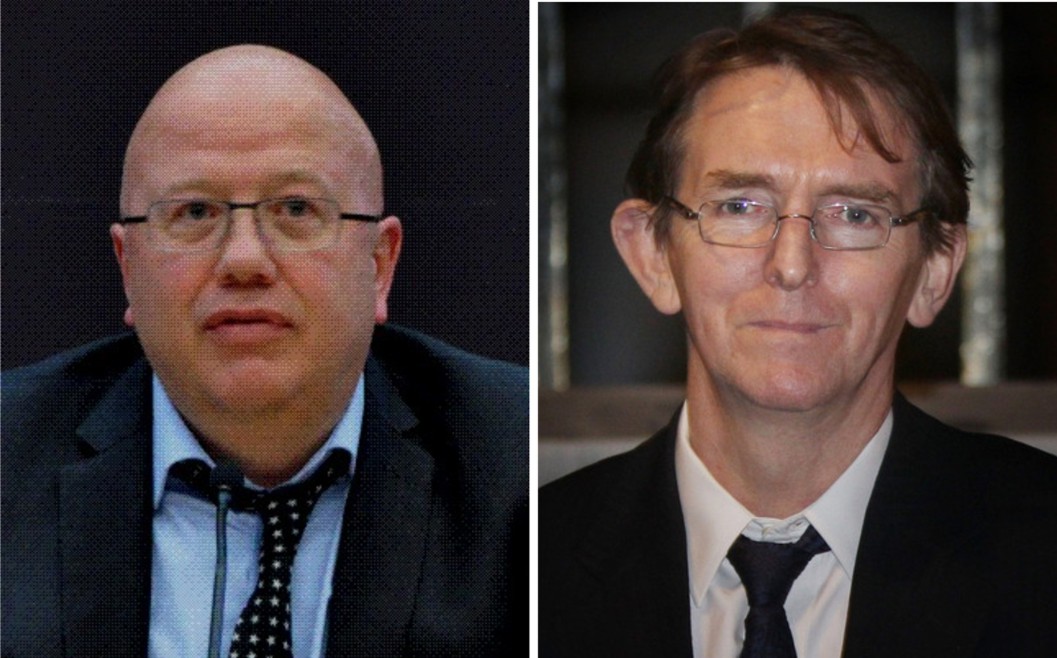
[Left, editor Chris Blackhurst of the Independent, right, editor Tony Gallagher of the Daily Telegraph]
1. Examine first some key happenings at the Knox/Sollecito trial
Throughout the trial which began back in January 2009 the defense teams often seemed down or depressed or distracted or floundering.
Reports surfaced in Italy that one or two of them might even have considered walking. Knox defense counsel Luciano Ghirga was reported as nodding off or distracted. Sollecito defense counsel Giulia Bongiorno was photographed seemingly showing some exasperation with Sollecito and at zero notice she missed several days in court.
Amanda Knox’s testimony over two days on the stand in June 2009 was widely seen in Italy as a disaster. From then on many in the court and throughout Italy believed this seemingly callous, evasive, forgetful girl had to have had a role in Meredith’s death.
Having failed to attend to observe any of the key forensic tests at the Scientific Police labs in Rome, the defenses were able to introduce some forensic witnesses who testified that there might, possibly, somehow, be contamination in the collection and tests which they chose not to witness, but they never came close to showing how.
By the summations in November 2009 both defenses seemed to be seriously floundering.
2. Fast forward to Friday 20 November 2009
What happened on 20 November might well have made it the defenses’ very worst day.
On that day during their summation the prosecution BEHIND CLOSED DOORS devoted an entire day to reconstructing how Meredith died and the events in the few hours before and since.
The presentation was closed because Judge Massei had ruled in favor of Meredith’s family to close the court to the media when any upsetting material was being presented. For example the results of the autopsy had been presented in closed court.
This resulted in the Massei judges and jury receiving a much more disturbing picture than the Italian public and especially the foreign publics ever did.
The Italian media pieced together what had been presented behind the closed doors on 20 November and Il Messagero and several other Italian newspapers published it several days later. You can read a combined summary in this post here.
To our knowledge none of that summary of events ever appeared in the US or UK media, so the full impact of the reconstruction felt by the jury and to a lesser extent by the Italian public was never felt at all by the US or UK publics.
This excerpt is from that post:
We have left out the depiction of the final struggle with Meredith, which is extremely sad and disturbing. In the evidence phase this was testified-to behind closed doors at her family’s request and we have never posted anything from those sessions….
23:21 - Amanda and Raffaele go into Meredith’s bedroom, while Rudy goes into the bathroom.
23:25 - A scuffle begins between Amanda, helped by Raffaele, and Meredith. The English girl is taken by the neck, then banged against a cupboard. Rudy Guede enters and joins in.
23:30 - 23:45 Depiction in the timeline and computer simulation of a horrific struggle with Meredith
23:50 - Amanda and Raffaele take Meredith’s mobile phones and they leave the apartment. Guede goes into the bathroom to get several towels to staunch the blood, then puts a cushion under Meredith’s head.
That simulation video was a second-by-second depiction of what the crime-scene specialists from the Scientific Police in Rome had concluded, from the position of Meredith’s body in the room, evidence traces and the placing of various objects, and the many wounds described in the autopsy.
It was extremely difficult and laborious to get just right, and every tiny movement of the four that it depicts in three-dimensional space had to be able to stand up unchallenged - as they did.
The fight with Meredith took a horrific fifteen minutes. It only ended when she was lying bleeding on the floor, her hands grasping her neck. She was locked in her room to die, with her keys and phones removed to make sure she could not save her own life.
This was not a minute or two of hazing and a slipped knife. The evident intention was to see her dead - and in the reconstruction it required THREE ATTACKERS to explain all the evidence points.
The prosecution never entered the video into evidence so it could not be leaked to the public (the Sollecito family already stood accused of leaking one video) but the effect on the jury seems to have been profound and the defenses could do nothing to blunt it.
The lone wolf theory was well and truly dead in that courtroom and a perception of three attackers was well and truly alive. The defenses did what they could in their summations but they were unable to shake the perception of a depraved three-against-one attack.
A few days later a verdict was announced. By a UNANIMOUS verdict Sollecito and Knox were found guilty.
3. Fast forward to the first-level appeal before Judge Hellman in 20011
Judge Sergio Matteini Chiari, the most senior judge in the criminal division, was appointed to preside over the appeal.
He was very experienced at presiding over murder trials and appeals. What happened next surprised many among the judges and prosecutors and Italian reporters and the Italian public generally. From the Italian Wikipedia:
Although the Assize Court of Appeal was to be chaired by Dr. Sergio Matteini Chiari, Chairman of the Criminal Division of the Court of Appeal in Perugia, in circumstances not well understood Dr. Claudio Pratillo Hellmann, who chairs the Labor Chamber of the Court, has been called on to preside over the appeal court,
The judge to the side of the main judge, Dr. Massimo Zanetti, came from the Civil Section, and both had had limited experience with criminal trials both rather remote in time (only the cases of Spoleto and Orvieto).
Judge Hellman readily consented to the defense requests. First to re-examine several witnesses previously heard on the stand during trial (primarily Mr Curatolo) and two new ones (Alessi and Aviello) intended to show that Guede or Aviello’s missing brother could have attacked Meredith with unknown others.
And second to appoint two independent experts who would re-examine the DNA on the large knife found in Sollecito’s apartment and the DNA for which traces were collected in Meredith’s room and the methods used for processing them.
The examination of the witnesses seemed to end indecisively, but the vague suggestions of the independent consultants that there COULD have been DNA contamination - never proven - was accepted readily by Judge Hellman.
The reconstruction and the showing of the simulation which the trial jury sat through in later 2009 was not repeated by the prosecution at the first appeal in late 2011. Judge Hellman showed no inclination to sit through the full depiction of the day or the horrific 15-minute attack on Meredith.
So the explanation of all the evidence points in the room and on Meredith’s body was never solidly brought home solidly to Judge Hellman or his jury. In his verdict he overturned the outcome of the first trial, provisionally pending any Supreme Court ratification, and he handed Amanda Knox a three-year sentence for framing Patrick Lumumba.
Having refused to see the reconstruction, he could very torturously argue that the attack on Meredith could have been carried out by a single person. If he and his jury had actually watched the video, they could never have argued that.
4. Fast-forward to the grounds of Dr Galati’s appeal to the Supreme Court
The Umbria Chief Prosecutor’s grounds for appeal were spelt out by him at a new conference in Perugia on Monday 13 February 2012. The PMF translation team will soon have the full document ready in English.
The summary of the grounds for appeal below is translated from the Umbria24 report and to our knowledge NO English-language website except this one and PMF has ever reported what are the full grounds.
Meredith case: the prosecution appeals to Cassation: the acquittal verdict should be “nullified”.
For the Chief Magistrates of the [Umbria] Prosecution, “it was almost exclusively the defence arguments which were taken heed of”
By Francesca Marruco
The first-level conviction verdict was “complete and thorough” while the verdict of the second-level is “contradictory and illogical”. For this reason, the General Prosecution of Perugia asks the Cassation to revoke or invalidate it.
“We are still extremely convinced that Amanda and Raffaele are co-perpetrators of the murder of Meredith Kercher” said the Chief Prosecutor of Perugia, Giovanni Galati and the Deputy Chief Prosecutor, Giancarlo Costagliola.
Verdict that should be revoked “The second-level verdict should be annulled/revoked…. There are precise reasons for revoking it”, Mr Galati went on to say. In the Hellman reasoning report on the verdict with which the second-level judges acquitted the ex-boyfriend and girlfriend “there are so many errors, and many omissions. There is inconsistency in the grounds for judgement, which brings us to nothing.”
“It is as if they had ruled ex novo [anew] on Meredith’s murder” added the Deputy Prosecutor, Giancarlo Costagliola, “basing their decision solely on the arguments of the defence.”
“Normally the appeal judge evaluates the reasoning procedure of the first-instance judge and compares it to new elements. But this one missed that out altogether: there is no comparison between the checks carried out in the first and second instances. Only what was carried out during the appeal was evaluated.”
Only defence arguments were taken heed of For the magistrates, in fact, the second-level judges “took heed, almost exclusively, of the arguments of the defence consultants or the reconstruction hypotheses that were largely to the benefit of the defense theses”.
The prosecutors who authored the appeal [to Cassation] also criticized the “method used”. “The first-instance verdict”, they wrote, “was summarized in just a few lines”,
“The verdict [which we] challenge completely ignored all the other aspects which corresponded with the accusation’s hypothesis, all the aspects which, on the contrary - as was seen in the reasoning report of the first-instance verdict - had been rigorously pointed out and considered by the Assizes Court [trial court] in its decision.”
“In examining the individual [items of] evidence, the challenged sentence has fallen into consistent procedural error in the weaknesses and evident illogicality of the grounds for its decision.”
Prejudice For the General Prosecution magistrates, the second-level [first appeal] judges appear to have shown “a sort of prejudice” with the “infelicitous preamble of the judge [the author], who is supposed to be impartial”, when he declared that “nothing is certain except the death of Meredith Kercher”, which to the others [Mr Galati and Mr Costagliola] is nothing more than “a resounding preview/forecast of the judgement” and a “disconcerting” affirmation.
The ten points The reasons for the appeal to Cassation which Perugia’s General Prosecution presented today against the acquittal verdict of Amanda and Raffaele are based on ten points of the second-level verdict.The first is the lack of grounds for the decision, in the decree of 18 December 2010, to allow the forensic testimony/expert witness in the appeal judgement.
The second, in contrast, concerns a contrary decision: the decision to not allow a new forensic investigation requested by the prosecution at the end of the ruling discussion. In the appeal to Cassation it is written that the Appeal Court’s rejection reveals “contradictoriness/contrariness and demonstrates manifest illogicality in the grounds for the judgement/reasoning report”.
The other points deal with the decision by the Appeal court of Assizes of Perugia to not hear the witness Aviello, also the definition of “unreliable” [in the Hellman Report] with reference to the witnesses Roberto Quintavalle and Antonio Curatolo, also the time of death of Meredith Kercher, also on the genetic investigations.
As well as the analyses of the prints and other traces, also the presence of Amanda and Sollecito in via della Pergola, also the simulation of a crime [the staged break-in], and also the exclusion of the aggravating circumstance of the crime of “calumny”.
Missing assumption/acceptance of decisive evidence In the appeal to Cassation there is also mention of the “missing assumption/acceptance of a decisive proof”
In other words, of that proof [presented at trial court] which consisted of “the carrying out of the genetic analysis on the sample taken from the knife by the experts appointed by the Court during the appeal judgement, who did not carry out the analyses of that sample, thus violating a specific request contained in the [orders given to them] when they were assigned to the expert-witness post”
“In the second-level [Hellman] verdict”, the magistrates said, “the judges sought to refer to this in their own way, by speaking of an “experimental method” by which these tests/checks could be carried out.
But this is not the case”, said Deputy Chief Prosecutor Giancarlo Costagliola: “Dr Novelli [the prosecution’s DNA consultant at appeal] spoke of cutting-edge technology, not of experimental methods”.
So Dr Galati, himself formerly a deputy chief prosecutor at the Supreme Court who for years handled nothing but Supreme Court cases and knows what constitutes a sound appeal argument, argued that Judge Hellman had made ten serious mistakes. (Aviello claimed in court that he had been bribed; instead of investigating, Judge Hellman very quickly move on.)
But even worse, that Judge Hellman had illegally vastly expanded the scope of the appeal. And he had illegally appointed the independent DNA experts.
Because of Hellman’s alleged sloppiness and overreach, the defenses now stood to lose EVERYTHING they thought they had gained - and had been so noisily jubilant about, especially to the media in the US. An arrogance not taken kindly to in Italy at all.
5. Fast forward to English language press reports of the past few days.
Nick Squires may have been the first to carry the report quoting unnamed sources in the Daily Telegraph.
Two prosecutors in Perugia, where Miss Kercher was murdered, face accusations of wasting 182,000 euros (£150,000) of public money by commissioning a controversial 3D video which purported to show how the murder unfolded.
The contentious video, which defence lawyers said was based on circumstantial evidence, showed Miss Kercher being held down and stabbed to death by Miss Knox and her two co-accused.
The Leeds University student and her alleged murderers were represented in the 20 minute film by animated ‘avatars’. It was played on a big screen to the judge and jury in the original trial in 2009.
The National Audit Office is now investigating the prosecutors, Giuliano Mignini and his deputy, Manuela Comodi, on whether the video was a necessary part of their case.
If found culpable they could have to pay the money back to the prosecutors’ office.
Really? Accusations? Wasting? Controversial? Purported? Contentious? Now investigating?
Note that Nick Squires didnt name his sources. He didnt explain why he claimed the video simulation was controversial. (It wasn’t at all controversial at trial in 2009.) He didnt seem to know who had made the accusations or how or when they had been made or to who.
He failed to mention that the video was played behind closed doors, and that the defenses had no comeback to it. He said it depicted Knox, though in fact it deliberately didn’t. He didn’t explain that the depiction of the fight lasted 15 minutes. He didn’t explain that the depiction of three attackers was overwhelmingly convincing to Judge Massei and his jury.
Nick Squires’s report was nevertheless comparatively brief and restrained in contrast to that of Michael Day which came next. His very much embroidered version was published in the UK Independent. The accusatory tone and serious charges in Nick Squires’s and Michael Day’s reports were then picked up without checking by a large number of American and European media outlets.
See the reports here and here and here and here and here and here and here .
Note that not one of these reports was checked out in Italy, and that all these reports slam Mr Mignini (yet again) and indicate that this was an OFFICIAL accusation of “wasting public funds”. Many US reports wrongly state that the British audit office is investigating.
Michael Day claimed that “Agostino Chiappiniello has said he suspects the two of inappropriately spending €182,000 (£148,000) on a crude and cartoonish 20-minute video,”
Really? Agostino Chiappiniello, did you tell Michael Day precisely that?
Michael Day then states that “In both trials [Mr Mignini’s ] interventions were notable for the outlandish motivations and personality traits he attributed to the defendants. He promoted the idea that the murder was the result of a sex-game that got out of control, despite having little or no evidence to support the theory.”
Really? Actually Guede and Knox and Sollecito were all CONVICTED of a sex crime at trial, because to their judges and juries that is what the evidence inescapably pointed to.
And Michael Day concludes with yet another misleading statement (see above on Dr Galati’s appeal for the correct facts which he seriously garbles here.):
Judges at the Cassation court may only overturn the first-appeal verdict on technical grounds. Thus, no new evidence may be introduced and the prosecution’s room for manoeuvre is limited. The pair could not be retried for the same crimes.
Really? But nobody is talking about the pair being retried for the same crimes. This does not arise. Under Italian law they STILL stand accused of the same crimes as they were before trial back in 2009 until the Supreme Court signs off on their case.
6. Fast-forward to the ITALIAN reports of the past two days
Translation by our main poster Jools from an Umbria24 report, posted on Wednesday, which tells a very different story.
[There was several months ago]”¦ a complaint from “a group of private citizens” who did not sign their names and surnames about an alleged misuse of public money….
No comment from the two prosecutors of Perugia, no comment on this news.
As we have learned the prosecutors have not received any legal papers regarding the investigation and they heard of the news from the press.
Who will pay? To decide if the expense was adequate for the State coffers will be the task of the prosecutor at the Court of Audits of Umbria.
Meanwhile if the Supreme Court were to overturn the judgment of the Perugia appellate court, the costs would be paid by the two accused [Knox and Sollecito].
If instead the Supreme Court were to confirm the acquittal, the bill for 182 thousand euros would be borne by the Italian State.
7. In summation
Quite a fizzle. The prosecutors are NOT quaking in their boots. They didnt even know about it. And the full force of Italian justice does NOT have them under the microscope.
- The anonymous complaint was filed over two months ago. Nick Squires and Michael Day sure did not make that clear.
- If the enquiry is actually pursued (not at all certain) then it is Amanda Knox and Raffaele Sollecito who could in fact be stuck for the costs (plus VAT) of producing the video. Nick Squires and Michael Day sure did not make that clear.
- The Corte dei Conti is not the equivalent of a criminal or civic court, it is essentially an investigating tribunal. Nick Squires and Michael Day sure did not make that clear.
- The Corte dei Conti has so far not accused anyone of anything, and it may never do so. It sure doesn’t seem to regard the matter as urgent. Nick Squires and Michael Day sure did not make that clear.
- In fact it has taken over two months to, well… not even assemble the evidence or bother to get in touch with Mr Mignini or Ms Comodi. Nick Squires and Michael Day sure did not make that clear.
On the same basis Judge Hellman could in theory be accused of incurring TWO huge cost over-runs.
- One for running his appeal court only on saturdays to suit just one defense lawyer, when the overtime costs to Italy became huge - substantially more than the cost of the video. Nick Squires and Michael Day sure did not make that clear.
- And one for (according to Dr Galati) illegally appointing the two DNA consultants - the costs of that investigation to Italy became much more than the cost of the video. Nick Squires and Michael Day sure did not make that clear.
The reconstruction video is so powerful and accurate that it could, if it is watched by the Supreme Court in Rome or a new appeal court in Perugia, be quite devastating to the defense of the two accused. This is because it depicts the full cruelty of the attack on Meredith - and it shows that THREE people had to have attacked her.
So who filed the anonymous complaint against Mr Mignini and Ms Comodi? And who used Nick Squires and Michael Day as puppets to make a private claim look official, and make that hoax go viral? We are sure Dr Galati will have all the answers before many days go past. Calunnia charges might apply.
Someone must REALLY fear that Sollecito and Knox will be cooked if that video reconstruction ever gets shown again. Case closed? At one stroke.
[Below: Knox and Sollecito, who could be billed over $300,000 for the reconstruction video]
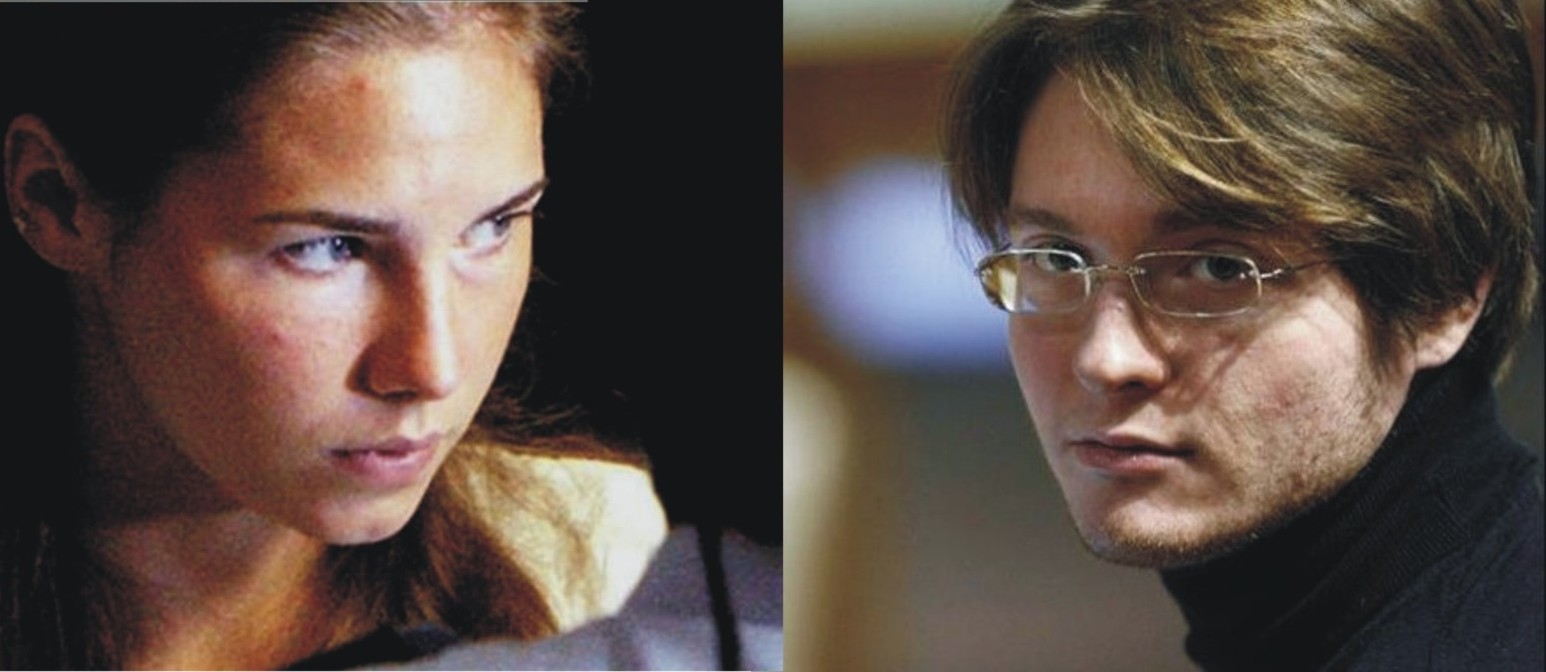
Thursday, March 22, 2012
No, Book Agent Sharlene Martin, Your Client Raffaele Sollecito Really IS A Hot Potato
Posted by Peter Quennell
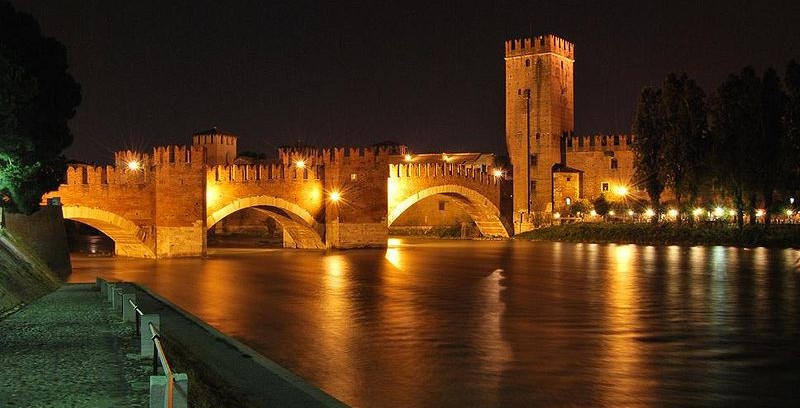
[Above and below: Verona in north Italy where Sollecito is accepted by the university for a masters degree]
Los Angeles book agent Sharlene Martin posted this gung-ho comment on a Daily Telegraph thread (presently page seven) late Sunday night UK time.
I couldn’t be happier for Amanda Knox getting $4M for a book deal. What happened to her and Raffaele is a sin. BTW, I represent Raffaele for his book that we’re working on.
There is no restitution for wrongful conviction and both families incurred absorbent costs to help exonerate them so good for them if they help recoup the lost monies. They’ll never recoup the lost time of 4 years in prison.
She posted that at just about the same time we posted (post below) on the various hot-potato qualities of Raffaele Sollecito. Since then… no further word.
In terms of the book’s sale to a publisher she may not have much to worry about.
For this reason the deal is probably set in stone: Simon and Schuster are a fully owned subsidiary of CBS Broadcasting, which has gone to eye-popping lengths (post on this soon) to remain in bed with the Knox-Mellases.
The content of this ill-considered book might be a lot more problematic. Sharlene Martin might still believe that there are just a few open questions, easily accommodated to by the FOA talking points. In actual fact there are hundreds.
And the FOA have studiously stayed away from creating the alternate-universe scenario that Sollecito and Andrew Gumbel must now create, if they don’t want to end up as the laughing-stock of the western world.
This is a road-map of the Sharlene Martin-Andrew Gumbel-Simon & Schuster minefield.
- Here is the Machine’s list of 10 lies uttered by Sollecito which was posted three years ago and so far never challenged.
- Here is Kermit’s list of 150 questions which so far have never been answered by either of the formerly convicted perps.
- Here is Kermit on Sollecito’s footprint on the mat which Judge Micheli and Judge Massei accepted and Judge Hellman only weakly and possibly illegally rebutted.
- Here again is the Machine on RS’s various alibis the strange arc of which two years later is still unexplained.
- Here is lawyer SomeAlibi’s list of evidence points of a year ago which Hellman weakly rebutted or ignored and which still call for convincing explanations.
- Here is lawyer James Raper’s presentation with Powerpoint artwork by Kermit of the ONE convincing scenario that the evidence still points to.
Hmmm. Lotta questions to be answered in a hurry, if the book is to stir a wave of sympathy or outrage to stop the Italian Supreme Court punting the case back to Perugia to get it right this time around.
Above and below are images of the northern Italian city of Verona. It has the largest and best preserved intact Roman ampitheater in the world. It also has a very good university.
Possibly legitimately or possibly by way of strings pulled by his father, Raffaele Sollecito had gained a place in a graduate class at the university there for the Department of Computer Science’s masters degree in computer engineering.
In January Sollecitos father made several statements from Bari to the effect that Raffaele really was done with Amanda and dreams of visiting Seattle and would soon be headed for Verona to complete that postgraduate degree.
Rather suddenly, less than two months later, Raffaele is headed for Seattle, with his father and sister seemingly in hot and unexplained pursuit. Microsoft is suddenly mentioned as a firm which will interview him, masters degree or no masters.
So what happened? Well possible one explanation might be found in the comments area of every recent Italian report which allows them, which suggests that just about 100 percent of those posting don’t really like him.
That Italians dont really like him and are even inclined to physically take after him is also well illustrated in this story which we posted 18 months ago.
Sollecito was in the very modern solar-heated Terni prison for most of last year. He was moved back to Capanne this year just before the trial, amidst his loud complaints that Capanne lacks the internet connections for his computer-science homework.
Sollecito has just received word that he failed the virtual-reality entrance exam that he took at Verona University last March.
When he was being transported there in a police van for the exam, he was yelled at by an angry crowd when the van stopped at an autostrada rest-stop for what Americans call a bathroom break.
He was bundled back in, and the police van took off in a hurry. No bathroom break? That must have rattled his exam-taking composure, that is for sure.
Another possible explanation is that Sollecito is putting half a world between himself and Italy, because the Sollecito-Knox-Mellases realize that in light of Dr Galati’s formidable appeal that legally they are cooked.
Lots of good interview questions for Microsoft above. And a suggested new subtitle for “Presumed Guilty: My Journey to Hell and Back with Amanda Knox” ?
“Oops. This book idea really wasn’t very smart.”
[Below: A Verona audience waits in ampitheater for Sollecito to be fed to the lions, if they’ll have him]
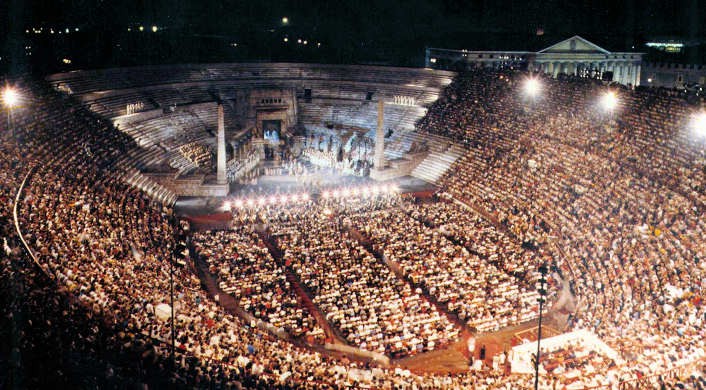
Sunday, March 18, 2012
Could A Growing Asymmetry Between Raffaele And Everybody Else Be Ensuring No Sleep In Seattle?
Posted by Peter Quennell

[Louise Burke, Jen Bergstrom, and Tricia Boczkowski, top editors at Sollecito publisher Gallery Books]
Amanda Knox seems to have had a history of putting her foot in it and then (sometimes) when she realizes it she tries to make amends.
That seems to be the arc of her Berlin experience where she upset people by quitting a plum intern job at the parliament after a day and then retroactively at least worrying about it. That may have been what she was doing at the first meeting with her parents in Capanne prison when they very quickly shushed her up.
Meredith seems to have found Knox hard to take with her noise and grubbiness and sharp elbows and general pushiness. But Amanda Knox was losing her few new friends in Perugia fast, and possibly her job in Patrick’s bar, and Meredith seems to have fatefully banked on Amanda Knox coming full circle soon.
There are instances recorded almost to the end where they both seemed to try to get along, although Meredith may have brushed Knox off on Halloween night when Knox made unanswered calls, maybe to ask if she could tag along.
Enter Sollecito.
Seemingly a classic loner with no close friends in Perugia, no previous genuine deep relations with girls, apparently no prior sex, a year or two behind the rest of his class in completing his degree, with serious time given to beastie porn and Japanese anime and Japanese manga. Believed to have had a history of cocaine use with some incident on record back in Bari. Loves knives.
Seemingly forever kept on a very short string by his father, who called him on the phone at least once daily, and who made sure to keep his son’s bank balance on a level with Raffaele’s legitimate monthly expenses.
Seemingly already nervous prior to Meredith’s death that Amanda Knox might soon dump him. That after less than one week.
Our Italian poster ncountryside translated these statements by Dr Sollecito which seem to show Francesco trying hard to get a grip over his slippery son.
From a family conversation recorded in Capanne prison
And then this f@cking knife that you carried back and forth .... I told you about leaving it at home .... You’re an idiot from this point of view .... aren’t you? .... and then the f@cking point that you could have avoided the [marijuana] joints .... You promised a few years ago about it, didn’t you? You gave us your promise, to me and to your sister that you would not have used them again, and instead you have not given a f@ck .... is that clear?”
From another family conversation recorded in Capanne prison
If the investigators are finally realizing what the real dynamics of the matter is ... automatically understand that you have nothing to do with [rude in italian] ... Do you understand? ... Amanda can be more or less involved in this matter ... more or less I do not know and do not give a damn ...
She will know something ... precisely ... especially considering all the versions that she has given, maybe she has not told the right one because she was worried about what this character the little negro [i.e. Patrick Lumumba] has managed to do, something like that ... do you understand what I mean? ... But you have nothing to do with [rude in Italian] ... and they understood ... now this morning or Monday there will be also the checking of your computer ... they have already cloned the hard disk ..
If Amanda was home ... if she was out, wtf were you doing? ... were you at the computer? ...... We cannot understand, this [=AK] within three days, when she went to the questura ... she has four to five different versions ... she has pulled in the little negro a@@hole ... Is a strange personality this girl, isn’t it?.
In his second and third alibis Sollecito definitely seemed to throw Knox under the bus.
It was only after hearing of Sollecito’s second alibi from police interrogators that Knox headed off down the slippery slope that now results in a confirmed three-year sentence for her and calunnia trials for both herself and her parents.
It was right then that Knox pointed the finger at Patrick Lumumba, in her own second alibi when still only a witness.
Upon his release by Judge Hellman, Raffaele Sollecito adopts a high and surprisingly jubilant “catch me if you can” profile not dis-similar to that which has been the downfall of many a psychopath throughout history.
He goes on national TV and avoids all the hard questions and he bristles with narcissistic bravado. He makes several statements about himself and Knox from his seclusion in Bisceglie north of Bari, which his father then publicly tries to pull him back from.
A seemingly naive ghost-writer, Andrew Gumbel, is invited in to capture Sollecito’s immortal thoughts, and he seem to have instantly started to mirror Sollecito’s extreme bravado.
More or less the opposite of the cautious, subdued book approach of the Knox camp. Although she may not have wanted this, Amanda Knox will be tied forever to Sollecito in the opportunistic, self-serving title: “Presumed Guilty: My Journey to Hell and Back with Amanda Knox”.
Book announcements are totally mute about all the legal trouble headed down the pike toward himself and Knox and their two families. The publisher’s announcement makes this inaccurate statement:
“Sollecito was an unwilling participant in a case that riveted the world. The Italian media convicted the young couple before any evidence had even been heard,” Gallery Books said in a statement. “Over and over, Sollecito came under pressure to change his testimony and get himself off the hook, but he refused to betray Amanda and he refused to lie.
“In “˜Presumed Guilty,’ Sollecito will finally tell his side of the story “” from his first meeting with Amanda Knox, to his arrest, prison time, subsequent release, and current relationship with the woman he stood by through the worst ordeal of both their lives.”
Really?! No, in fact Sollecito threw Amanda Knox under the bus as soon as he was leaned on, in his alibis two and three. He left her under the bus throughout the whole trial. Even after she rather desperately reached out to him in Capanne prison. And he lied again and again and again. Besides:
- Sollecito seems to show no concern at all that Perugia’s formidable chief prosecutor Dr Galati has filed a devastatingly strong appeal with the Italian Supreme Court.
- Sollecito seems to show no concern at all over his own family’s upcoming trial or the fact that they might end up in prison (which could cause his father to lose his medical license).
- Sollecito seems to show no concern at all that, for over-vigorously trying to defend him, his sister Vanessa has now permanently lost her plum job with the Carabinieri.
And now? Well, now there is a new report from the UK press, which seems to keep stringers permanently on the ground in Seattle and may have a direct pipeline to the Knox-Mellases. The report includes this:
Amanda’s new boyfriend, musician James Terrano is understood to be unhappy about Raffaele’s arrival.
James Terrano has himself been very cautious. He is unlikely to have let that damning remark leak out without a heads-up to Amanda Knox and her family. This seems yet another sign that the secret Seattle meetings are not simply a lovefest.
Both families seem to be struggling with a loose cannon called Raffaele.
Wednesday, March 14, 2012
Rome Appeal Court Rejects Vanessa Sollecito’s Appeal For Reinstatement In The Carabinieri
Posted by Peter Quennell
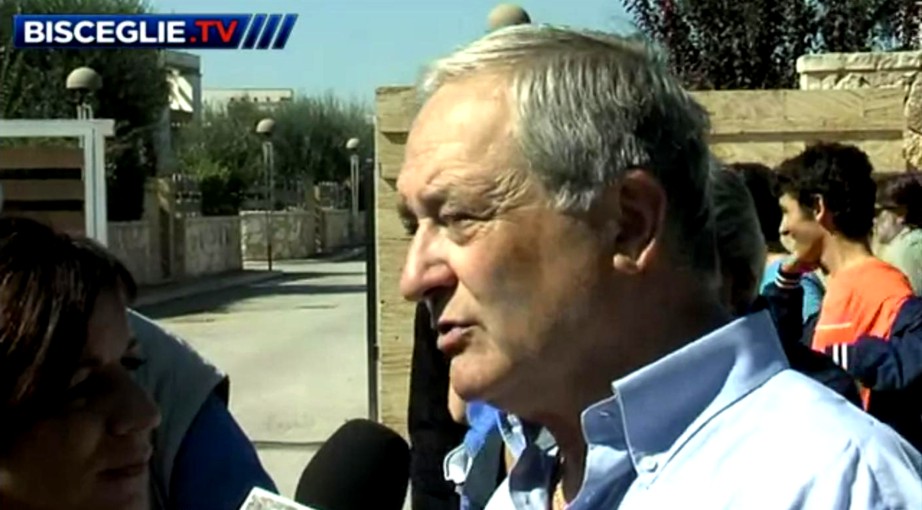
[Above and below: Francesco, father of Vanessa and Raffaele, outside their Bisceglie family home late 2011]
In 2008 Vanessa Sollecito and her father Francesco were caught on tape discussing the manipulation of Rome politicians into forcing changes upon the investigation team in Perugia.
Vanessa was fired from the Carabinieri the prestigious Italian national civil-military police force in November 2009 for demonstrating behavior and psychology inappropriate to a law enforcement officer’s job.
Our Italian poster ncountriside has just alerted us to the posting of the official statement that her appeal has been turned down.
The European Court is quoted in that report as confirming that national members have the right to fire official staff for psychological and behavioral cause.
The Carabinieri carried out a very thorough investigation which included the secret bugging of her mobile phone and her father’s phone. Jools translated one key conversation here. Her father suspects they are being bugged by the police but she blithely talks on, digging them in deeper.
This ruling was probably posted when Vanessa Sollecito was already in the air bound for Seattle (see the post below) but she would have known it was coming. This does not bode well for the criminal trial she faces along with her close family, possibly starting in Bari at the end of this month. The charges could incur prison terms.
The Sollecito family arc has almost never been reported on in the English language press. In 21 June 2008 Tom Kington of the Guardian did file this brief report.
The investigation into the murder of British student Meredith Kercher in Italy took a dramatic twist yesterday when the family of one of the suspects was accused of attempting to interfere with the inquiry.
Police tapping the phones of the father of Italian student Raffaele Sollecito overheard discussions that appeared to suggest plans being made to get senior politicians to use their influence and get detectives whom the Sollecitos considered hostile taken off the case. The phone tap information is in files handed over to lawyers as magistrate Giuliano Mignini officially completed the investigation into the strangling and stabbing of Kercher, from Surrey, who was found on 2 November semi-naked in a pool of blood in her bedroom in Perugia.
‘We’ve got to flay the Perugia flying squad,’ a family member was overheard saying, according to the Italian newspaper Corriere della Sera. ‘If we can get rid of the head of homicide and that other one, we’ll be OK.’
Relatives of Sollecito, including his sister, a policewoman, were also overheard discussing politicians who could help their case. Giulia Buongiorno, a lawyer and MP in Silvio Berlusconi’s ruling coalition, has now been retained to represent Sollecito. ‘She can help out on this case at a political level,’ Sollecito’s father was overheard saying.
Sollecito’s father, Franco, a well-to-do doctor from Bari in southern Italy, has campaigned to prove his son’s innocence, even to the point of allegedly leaking to a TV station a video obtained from the crime scene showing Kercher’s corpse, as well as highlighting perceived errors by the investigators, including the delayed recovery of parts of Kercher’s bra strap which were found to carry Sollecito’s DNA.
Police are holding in custody Sollecito, 24; his former girlfriend and Kercher’s flatmate, American student Amanda Knox, 20; and a third suspect, Rudy Guede, 21. All three deny involvement in the vicious killing.
As you can see here, Italian reporting like that translated by Jools usually includes a lot more damning detail.
Thursday, February 23, 2012
Sollecito Ghost Writer Andrew Gumbel Reveals To MedaBistro How Ill-Informed He Is About His Client
Posted by Peter Quennell

[Above left: Sollecito ghost writer Andrew Gumbel; above right, Sollecito agent Sharlene Martin]
Right now Sollecito ghost writer Andrew Gumbel is making loud, silly claims like many other writers who came upon the case and first fired from the hip.
And then “mysteriously” went silent and have not been heard from again. We have helped to edge back from the brink several dozen such reporters. Perhaps they ought to thank us - oh, actually in several instances they did.
Here on Media Bistro Andrew Gumbel gives a shoot-from-the-hip interview in which he seems to display a terrible batting average on the hard truths. The interview is being smartly ridiculed in the comments below it by among others TJMK’s own well-informed pro-Meredith campaigner Bucket Of Tea.
Here, to help set Mr Gumbel straight before it is too late, is our own informed commentary on what he said.
A: It’s a rule of thumb that prosecutors dictate media coverage in a criminal trial. They are the ones who bring the charges, and are either vindicated or successfully challenged in court; the texture and the substance of the defendants’ stories tend to get lost. And so it was here. The media coverage focused largely on the yes/no question of whether Amanda Knox and Raffaele Sollecito were guilty.
Untrue.
The mechanics of the case from the inside “” how they were interrogated, why they were prosecuted even after the most obvious perpetrator, Rudy Guede, was caught and convicted, the behind-the-scenes haggling between lawyers, defendants, expert witnesses, court officials and others “” have been revealed only in glimpses, if at all.
Untrue.
Both Amanda’s book and Raffaele’s book are sure to shed light on how and why this grotesque miscarriage of justice arose. I would venture to say Raffaele’s story is even more absorbing than Amanda’s, because it was his family which orchestrated the detective work that made it possible to dismantle the case against both of them piece by piece. It was a high-wire act from beginning to end, and it’s a thrilling tale.
Untrue.
Amanda and Raffaele can’t bring Meredith back, but they can give everyone the benefit of the truth. It’s an important story to tell. And after all they have gone through “” including the huge hit their families took to their reputations and their pocket books “” they certainly deserve both vindication and compensation….
Untrue.
Not only will the book leave no doubt about Raffaele’s innocence; everything Raffaele and his family have to tell, backed by previously unpublished documents in the case, suggests that his incarceration had almost nothing to do with the actual evidence but had another motivation entirely “” to be revealed when the book comes out…..
And untrue.Absurdly so.
Thirty plus judges who reviewed the case had no “other motivation entirely”. Please drop the smears of Italy and Italian justice. It isn’t becoming and there are already enough calunnia suits for felony defamation in the works.
And Sollecito’s family orchestrated no amazing detective work that showed that all the evidence was at fault. The defenses had every opportunity to do so in 2009 at trial and they did a truly terrible job. The Supreme Court already knows this so in what way exactly have they won?
In fact the main thing the Sollecito family is famous for right now is that they all face a trial in Bari. The charges are (1) illegally releasing video evidence to a TV network and (2) illegally attempting to subvert the police and prosecution by political means.
Now that’s true. Its seems two serious laws may have been broken. Andrew, read up about your Dear Clients here and especially here. They haven’t even attempted to “explain” all that as yet, and are almost certainly going to go down at trial.
And by the way, the evidence that the Sollecito family leaked to Italian TV? Video images of the naked body of Meredith. Very nice clients? You’ve been conned.
Monday, October 03, 2011
Is The Raffaele Sollecito Defense Team About To Separate Him From A Radioactive Amanda Knox?
Posted by Peter Quennell
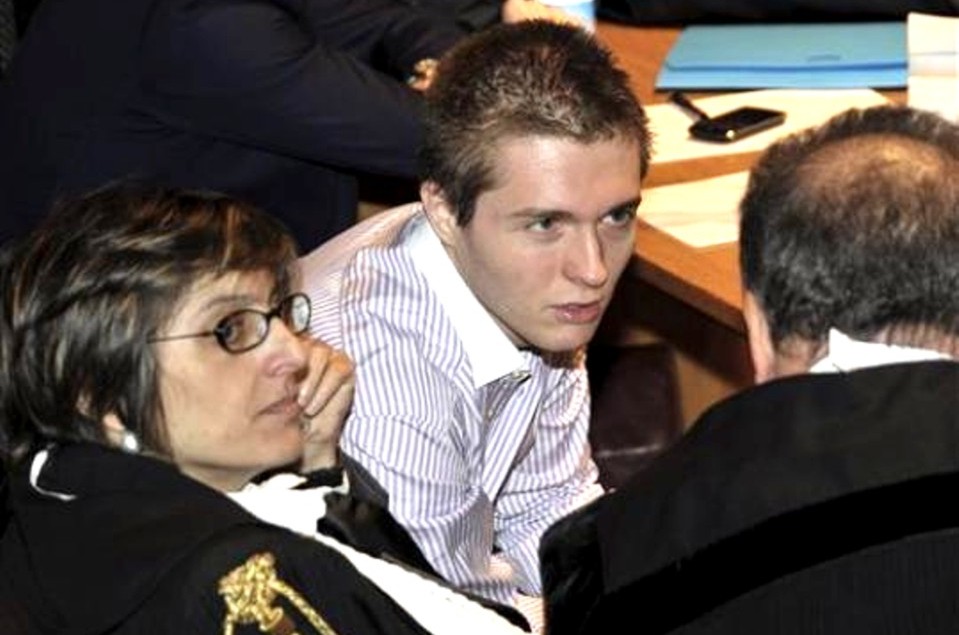
Sollecito has at least five advantages over Knox in what may be the final day of court tomorrow.
First, the smartest and most influential of all the lawyers in MP Giulia Bongiorno. Second, a relatively attractive family which has run a low-key smiling campaign. Third, relatively little evidence (the bra clasp and footprint) placing him at the scene of the crime and unlike Knox no alibi that says he was there.
Fourth, no obvious motive for either the murder or the cleanup compared to the many possible motives for Amanda Knox. And fifth, a weak wishy-washy personality on which Bongiorno has already played, casting Knox as the lead player in the drama and Sollecito as either accidentally there or not at all.
The mood does seem to be moving against Amanda Knox now as the extreme arrogance of the million dollar campaign sinks in. And if her “spontaneous” remarks to the court tomorrow follow her usual pattern, they will yet again make her look callous and concerned only about herself.
Several reports are out now in Italian harking on these themes. This report by the Associated Press with a possible nudge from the Sollecito team gives a sense of what the Italian reports are saying.
Even in Sollecito’s native Italy, it is Knox who commands the most media attention. Two prominent celebrity and gossip magazines, “Oggi” and “Gente,” put Knox on their covers during the final week of arguments in the appeals trial, and newspapers characterize him as being in the background.
Not even prosecutors have portrayed Sollecito as the main protagonist in the murder of Meredith Kercher on Nov. 1, 2007. According to their version, Sollecito held Kercher from behind while Knox stabbed her and another man tried to sexually assault her. Ivorian immigrant Rudy Guede was convicted in a fast-track trial and saw his sentence cut from 30 years to 16 years on appeal.
Attention during the investigation focused intensely on the two young female roommates as the world and prosecutors searched for a motive. Knox was portrayed as sexually promiscuous and lacking inhibition, while at the same time working hard to support herself and trying to learn Italian; Kercher was depicted as more serious and studious, who had at the end of her life began to chafe at her American roommate’s sloppiness.
The good girl/bad girl dichotomy drove headlines across the globe, while Sollecito “” the mild mannered boyfriend “” was largely overlooked in a supporting role.
It’s a role that his defense lawyer plays up. Sollecito is the son of a wealthy doctor from southern Italy who hired a crack legal team to defend his son. It’s led by Giulia Bongiorno, who defended former Italian Premier Giulio Andreotti on charges of mafia association.
“It’s not by chance that Raffaele arrived in this trial as the boyfriend. Nothing connects Raffaele to the crime,” Bongiorno said in her closing arguments last week. “With a girlfriend, you usually get a family. Raffaele got a murder.”
She said the few pieces of evidence in the “Amanda-centric” trial relate to Knox, not to Sollecito. “Nothing connects him to the crime,” Bongiorno said.
Monday, June 27, 2011
Rudy Guede For The First Time Sort Of Accuses Knox And Sollecito Face To Face
Posted by Our Main Posters
1. Potentially A Huge Day
Tension was really fraught. Everybody involved in the appeal and everybody watching in Italy knew this could be THE day.
Guede had recently lost his final Cassation appeal and in a very hard-line ruling Knox & Sollecito had also been associated with the crime.
He was at this appeal hearing as a prosecution witness, because he had written a letter to the prosecution heatedly denying the claims of a former cellmate, Alessi, that he had said Knox and Sollecito did not attack Meredith with him, another two had.
With seeming nothing to lose, Guede could both deny Alessi’s claim and definitively point the finger of blame at the pair, and thus all three would remain locked up for many years.
2. How The Day Actually Went
Despite a turbulent day in court this was not a shapeshifter event. The problem was that Guede was far too nervous to testify.
He is not normally nervous, but it is rumored that the name of Sollecito’s mafioso Uncle Rocco might have been been whispered in his ear.
So his prison letter was read out for him by the prosecution, and it did include this.
This splendid, marvelous girl was killed by Raffaele Sollecito and Amanda Knox.
Then Sollecito lawyer Bongiorno grew increasingly frustrated in attempting a cross-examination, and Guede ended up barely saying a word. The letter alone is rather diminished evidence.
3. Duncan Kennedy for The BBC
See this on the BBC website by Duncan Kennedy.
Amanda Knox and her ex-boyfriend did kill Meredith Kercher, a man who was also convicted of the 21-year-old’s murder has told an appeal court.
After Rudy Guede confirmed he believed the US student killed her British housemate, Knox jumped to her feet saying she was “shocked and anguished”.
The hearing in Perugia is the first time that all three defendants have given evidence on the same day.
Knox, 23, and Raffaele Sollecito, 26, are appealing their convictions.
Child killerMiss Kercher, of Coulsdon, Surrey, was found with her throat cut at her Perugia flat after what prosecutors claimed was a sex game taken to the extreme.
Knox is serving a 26-year sentence for Miss Kercher’s murder while her Italian co-defendant and ex-boyfriend, Sollecito, was sentenced to 25 years.
Guede told the court that claims by a fellow prison inmate that he thought Knox and Sollecito were innocent were not true. He said he never made that claim to the inmate.
On 18 June, convicted child killer Mario Alessi told the appeal Guede had confided that Knox and Sollecito were innocent.
According to Alessi, Guede said he and a friend went to the house Miss Kercher shared with Knox with the intent of having sex with Miss Kercher and that when she refused, the scene turned violent and his unnamed accomplice slit her throat.
Drug-dealer Guede was jailed for 30 years for the sexual assault and murder of Miss Kercher after a separate fast-track trial. His sentence was reduced to 16 years on appeal.
Guede was in the witness stand as a letter he had written in response to Alessi’s claims was read to the court on Monday.
“This splendid, marvellous girl was killed by Raffaele Sollecito and Amanda Knox,” the letter said.
Guede has previously admitted being in the house at the time of the murder, but denies involvement in Miss Kercher’s death.
After cross-examination by the defence, Guede said he had always believed Sollecito and Knox were behind the murder.
“I’ve always said who was there in that house on that cursed night,” he told the court.
Knox stood up after Guede’s evidence and denied his claims.
“The only time that Rudy Guede, Raffaele and I were in the same space has been in court. I’m shocked and anguished.
“He knows we weren’t there and have nothing to do with it,” she said.
Sollecito said Guede was always talking “about a shadow that could be me and a voice that could be Amanda’s… we’ve been fighting shadows for four years. Our lives have been destroyed in a subtle and absurd way.”
Speaking before Monday’s hearing, Knox’s mother Edda Mellas told reporters she hoped that Guede would have the “integrity to stand up and tell the truth”.
She said her daughter was “always very anxious and nervous but I think she’s glad things are moving along. She feels things are going well,” but that it is, “hard to get too hopeful, especially after the first trial.”
Two other witnesses were called to counter claims made by another defence witness, a member of the Mafia named Luciano Aviello, who had told the court earlier this month that his brother - who is on the run - had killed Miss Kercher during a botched burglary.
The two witnesses - two inmates at the same prison as Aviello - testified that Aviello had said he had been contacted by Sollecito’s defence team to stir up confusion in the trial in exchange for money.
Witness Alexander Ilicet said Aviello had wanted the money for a sex-change operation.
4. Andrea Vogt For The Seattle PI
See this in the report in the Seattle PI by Andrea Vogt.
As if the appeal wasn’t bizarre enough, two convicts were called by the prosecution as counter witnesses Monday to contradict several inmates called by the defense earlier this month.
They maintained they had overheard in prison conversations about a plot among other inmates to testify in exchange for money and benefits, such as reduced prison time.
The person they heard was arranging things, they said, was Sollecito’s attorney, Giulia Bongiorno, who heads up Italy’s parliamentary justice committee.
She forcefully denied the corruption accusations in the break afterwards and vowed to file charges and take legal action against her accusers.
One claim by the inmates was that Bongiorno offered a sex change operation to Luciano Aviello. It would be helpful if some of this if it exists emerged on tape. What possible reason would they have to lie?
5. And So To The Bottom Line
Along with Judge Hellman’s increasingly evident bias, and the smoke being blown over the DNA, and the Sollecitos and Bongiorno not (at least not yet) investigated by the judge for alleged witness bribes, not to mention Uncle Rocco’s power to alarm even by whispered mention of his name, the Knox and Sollecito defenses are down, but not yet for the count.
6. And A Footnote On The Kabuki Dance
This for the first time on Guede’s side (but not on Knox’s or Sollecito’s side) crosses a public boundary between the three.
The Italian lawyer Cesare Beccaria explained it thus..
Saturday, June 25, 2011
Giulia Bongiorno’s Next Super-Witness: The Apple Of Her Witness Luciano Aviello’s Eye?
Posted by Peter Quennell
1. Anti-Aviello Testimony
This above is former Italian politician Vladimir Luxuria who, despite appearances, is fully male.
Testifying for the prosecution today, several rather convincing fellow-inmates have now contradicted defense witness Luciano Aviello’s 18 June testimony that his brother and one other had murdered Meredith.
Here is their claim. Defense counsel Dalla Vedova’s and Bongiorno’s “super witness” Luciano Aviello had told his fellow inmates that he wanted a sex change operation so he could end up looking like Luxuria.
This operation was to be paid for with money he claimed Bongiorno was offering for his false testimony to help RS and AK.
Giulia Bongiorno ended up outraged, and threatening lawsuits at this testimony, which she claimed was false (the paying of the money bit).
We are told an investigation will be started which may affect whether Bongiorno can stay on the Sollecito team.
[Added: yes, a month later we were told an investigation was under way.]
2. Bongiorno’s Other Problems
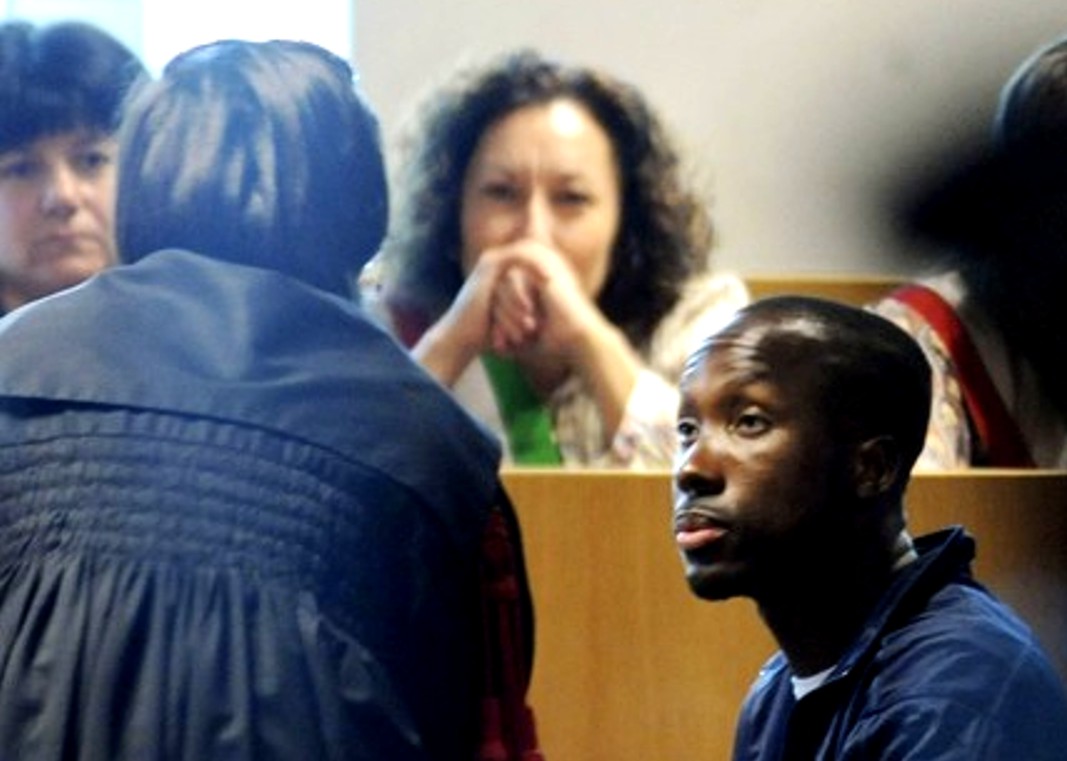
Above, a juror is grinning at Giulia Bongiorno’s frustration while Rudy Guede stonewalls her.
At various points in the trial and appeal she has dropped the ball in spectacularly goofy ways.
Bongiorno disappeared from the trial court late in 2009 for weeks with no explanation. She next appeared with a baby in her arms.
This morning she was sputtering to Judge Hellman that she only found out today about Rudy Guede’s letter - the letter reproduced in full in in this post which we translated into in English a full year ago.
She tried to have it excluded.
Here is another of Bongiorno’s sundry public disasters. She had claimed that an ex-burglar would climb into Filomena’s bedroom - but he never made it above eye-level with the window-sill.
In fact in three and a half years NO climber has ever made it through that window, though one or two did break in the far more logical way - via the hard-to-see and easy-to-climb rear balcony.
We do look forward to Giulia’s suit against the inmates. She has promised such suits often before.
Perhaps they will all arrive in a bunch?
Monday, June 20, 2011
Repeat of March 2010 Post: Guede Denounces Alessi, Blames Knox And Sollecito For Meredith’s Murder DRAFT
Posted by Peter Quennell
Guede will be required to testify on June 27. This is a repeat of Tiziano’s post of 12 March last year. At this point, Mario Alessi had made his claims to Sollecito’s lawyers at Viterbo Prison about Guede telling him he murdered Meredith with two others. And Rudy Guede had issued a heated hand-written rejection, denying this, ridiculing Alessi, and naming Knox and Sollecito as the murderers. Subsequent to this post, Prosecutors Mignini and Comodi travelled to Viterbo and interviewed both Alessi and Guede. This letter was Guede’s last major statement on the subject.
Please click here to read Rudy Guede’s hand-written letter from Viterbo Prison (above) in Italian.
Below is our translation of the letter as posted by TGCom.
Rudy Guede was obviously provoked into putting his version of events out by the claim of Alessi (see video at bottom of this post) that he had a colleague with him on the night, and also by the finding of the judges in the Dispositivo that he was the prime instigator.
The complete text of the letter written by the Ivory Coast man.
Guede’s letter to News Mediaset.
Viterbo 07/03/2010
As usual in this beloved beautiful country of ours, there are many dishonest people given over to lying. And there are likewise those who give these people a voice without the slightest questioning of their consciences, whether it’s worth the trouble of giving space to certain conjectures.
In recent days the only things I have heard have been blasphemous insinuations about me; baseless gossip which has done nothing other than harrying, hither and thither, TV news channels, even though for reasonable people it is the pure invention of a wicked mind.
It must be said that all I have heard in recent days in the media, about what has been falsely stated by this foul being by the name of Mario Alessi, whose conscience is nothing but stinking garbage, are purely and simply the ravings of a sick and twisted mind, his ravings are the dreamed-up, untrue declarations of a monster who sullied himself with a frightful murder in which he took the life of an angelic little human being, as is known throughout Italy. This fellow, now, is telling lies about things that I never said to him and (other things) that I never said, things that don’t exist either in this world or the next.
To his ““ or rather their- rotten declarations, it’s my intention to put in black and white that I never confided in this disgusting creature, since moreover that I’ve got nothing to confess or anything else (to say), and everything that I had to say I have already said to the judges and I will go on shouting and fighting while I am still alive, until the truth itself and justice itself prevail over such lies, and even less did I speak one to one or together with other people or with other inmates about my trial affairs, and if I had ever had something to say, don’t you believe that I would have talked about it with my lawyers? Giving rise to and giving credit to what is a blasphemous statement made by a sick mind, to a monster who had no pity for a child.
With this latest scenario, which my lawyers, my family and I are now used to, from this latest person, the monster Alessi, I hope that Italians and the rest of the world realise that they are dealing with pigs, pigs which stink of the slime of falsehood, but which, not withstanding everything, go around showing their faces and suffocating people with their fetid lying.
Like their umpteenth scenario which does nothing more than give me the strength and the awareness to struggle more than ever, so that the truth that they want to hide is revealed for everyone to see.
As far as I’m concerned, (I have) the serenity and the calm of complete peace of mind, as a person who does not parade this unfair suffering, but who trusts in justice and in the good sense of Italians.
And finally I wish that sooner or later the judges will recognise my complete non-involvement in what was the horrible murder of the splendid, magnificent girl who was Meredith Kercher, by Raffaelle Sollecito and Amanda Knox.
Guede Rudy
Below: Alessi’s statement at Viterbo Prison to Raffaele Sollecito’s defense team. Warning: this very self-serving statement by Alessi is graphic and offensive, as well as, in our view, almost certainly untrue.
Rudy Guede will be interrogated on the claims in this statement today Friday by Mr Mignini and Ms Comodi at Viterbo Prison. There could be news coming out of this interrogation later today.

